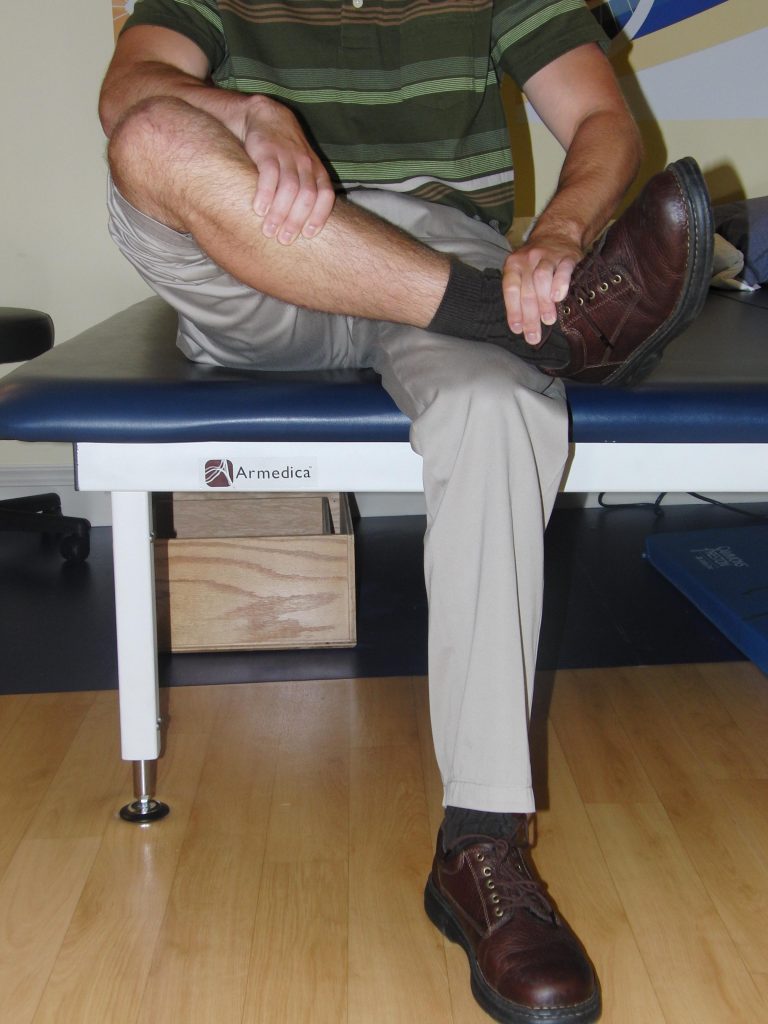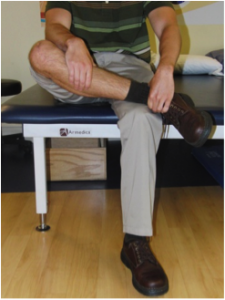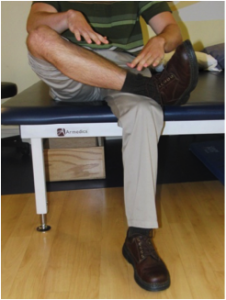Runners Knee versus Gas Pedal Knee – IT band syndrome

A middle-aged male adventure racer who had been struggling with right knee pain for six months sought my assistance. Adventure racing involves competing over multiple days, ultra-distance walk/running combined with other activities such as mountain biking, swimming, kayaking, and rock climbing. His knee pain was focused to the anterior lateral aspect of the right knee. He denied experiencing previous traumatic injury to his back or lower extremities; he denied having to wear corrective shoes or braces on his feet as a child.
His training included long trail walks/runs on the weekends of 6 hours duration. The knee was painful when walking and running longer distances and would eventually result in walking with a limp.
The significant findings of the clinical examination were in standing his right foot pointed outward more than the left. In relaxed sitting with his knee flexed 90 degrees and feet dangling the right foot and lower leg pointed outward (laterally) more than the left foot and lower leg. Active and passive range of motion of the hips, knees, ankles, and feet was within normal limits and symptom-free except for passive medial or internal rotation of the right lower leg and tibia. Active and passive medial rotation of the right lower leg was stiff and limited compared to the same movement of the left lower leg.
After the initial interview and examination, it was apparent that he was suffering from a repetitive use injury to the right knee possibly IT band syndrome. What was not clear was why the injury was only on the right side of the body.
Running/walking on trails for 6 hours is asymmetrical activity; involving both the right and left legs equally. Why was the right knee experiencing abnormal and excessive amounts of stress and injury? There was no history of traumatic injury, a congenital defect in the lower extremities which would be correlated with his right knee pain. The observed asymmetrical lower extremity alignment of the right foot pointing laterally made me suspicious that he may use the right foot to operate a pedal. Nine months ago, his job changed and his commute to work was 2 hours one way, 4 hours of driving a day. His right foot was pointing outward on the gas pedal 20 hours per week. He was doing more driving than walking/running and biking. This problem was a gas pedal knee, not a runner's knee. The pain occurred when walking/running, but the asymmetrical alignment was related to too much driving with too much lateral tibial rotation, foot on the gas pedal.
Interestingly, he reported he tried to use cruise control often, but when his right foot was not on the gas pedal it was still positioned in a laterally rotated position on the floorboard of the car.
He was instructed to modify his foot position on the gas pedal when driving to avoid lateral rotation of the lower leg. He was instructed to position his heel towards the middle of the car so that when his foot was on the gas pedal it was aligned straight due north and not pointed east or to the right relative to the body.
He was instructed in remedial exercise to increase the flexibility of the right lower leg (tibia) to medially/inwardly rotate. The goal was to have passive and active medial tibial rotation on the right which equaled the range of motion of the left tibia relative to the knee.
The exercise is done sitting, positioning the right ankle resting on the left thigh.

With both hands grasping the right lower leg (tibia) the lower leg is pulled/stretched in a medial direction with both hands. In this position, the foot will point towards the ceiling.

Once the maximum amount of passive medial tibial rotation is achieved using the muscles in the leg to hold this position of maximum medial tibial rotation and let go with the hands while holding the position with active contraction of leg muscles. It is important to strive to avoid sag of the lower leg but to engage the muscles responsible for medial tibial rotation to sustain the position of the maximum medial tibial rotation.

Finally he was instructed to consciously turn his right lower leg inward/medially when walking and running.
This client was able to eliminate his chronic right knee pain that he had been suffering for 6 months and run walk/run 6 hours pain-free within one week’s time.
This is an example of managing a repetitive use injury by identifying the excessive amount of asymmetrical repetitive activity which correlated with the injury. Once the offending alignment/movement was identified strategies were developed to modify the repetitive asymmetrical activity. Remedial exercises were developed to restore normal alignment and movement, and conscious modification of the walking/running form was used. The gas pedal knee was alleviated in a very short time period.
Damien Howell Physical Therapy – 804-647-9499 – Fax: 866-879-8591 At-Home, At Office, At Fitness Facility – I come to you, I do home visits Damien@damienhowellpt.com
